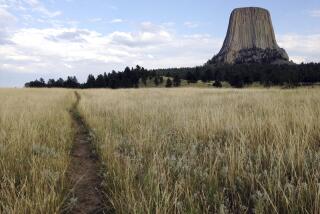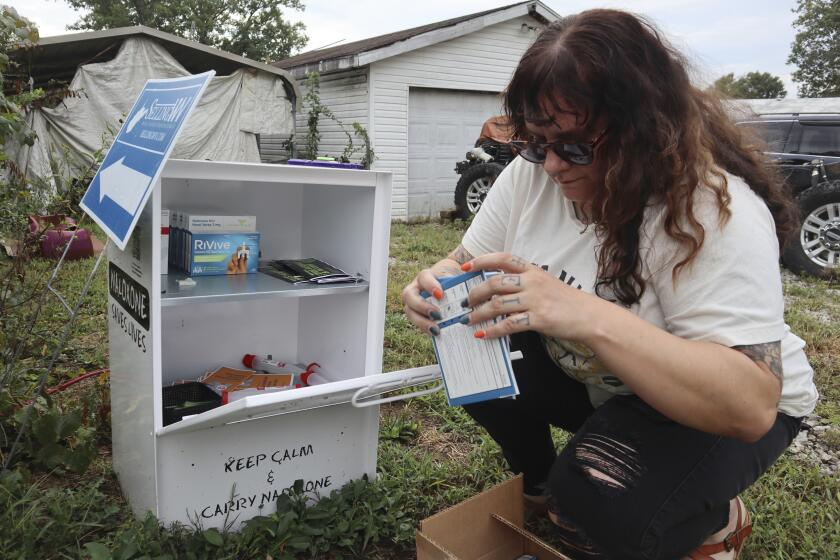Patrols Border on Danger
The two young soldiers, faces camouflaged, armed with M-16 assault rifles and .45-caliber pistols, lay in the desert sand 25 miles west of Yuma, Ariz., peering into Mexico. The darkness of a Southern California night made conditions perfect for their night-vision equipment.
The National Guard soldiers from the Los Alamitos-based 40th Infantry Division were there to observe and listen, part of the military’s silent war on drugs along the border.
“Some nights there’s no activity,” one said. “We haven’t come close to being in a firefight, but you do feel a rush when you’re doing your job right--looking at a group of people without them knowing you’re there.”
The military had been secretly patrolling the border until gunfire erupted recently in Texas: Last month, the leader of a Marine team from Camp Pendleton fatally shot an 18-year-old U.S. citizen in Redford, and in January, an Army Green Beret wounded a Mexican drug smuggler during a gunfight near Brownsville.
Weeks later, California National Guard officials invited a Times reporter to spend three days and nights with infantry soldiers along the border.
Eager to demonstrate that their units operate under strict rules of engagement, the National Guard for the first time allowed a reporter to visit a front-line listening and observation post in what has become an increasingly controversial part of the war on drug smuggling.
Last week, Congress approved a measure that would authorize the stationing of as many as 10,000 troops along the U.S.-Mexico border to help stop illegal immigration and combat drug trafficking.
Mexican Ambassador Jesus Silva Herzog said last week in Anaheim that putting troops along the border “would be complete nonsense.”
On the front lines last week, the two soldiers from Team Wolf at the desert listening post were aware of the danger and prepared to defend themselves, even though no shootings have been reported along the border in California. Hiding beneath a creosote bush, their weapons were “at the ready” and their bulletproof vests were laced uncomfortably tight.
The troops involved say they feel the adrenaline, fear and boredom common in combat.
For hours, the only sound was the eerie wind blowing across the crackling brush. Occasionally, they would cock their heads in the direction of Mexico, only 30 yards away. Conversation was limited to whispers.
About 90 miles to the west, Guard soldiers from Team Shadow, part of the 40th Division, looked through heat-sensitive gun sights mounted on four-wheel-drive vehicles pointed toward Mexico and O’Neill Valley, a route favored by smugglers.
Hunkered down on two mountain peaks, the soldiers from Team Shadow detected dozens of people crossing into the United States or gathering on the Mexican side of the border.
“This is what we do best. We catch dope,” said the Team Shadow leader, a staff sergeant who asked that his name not be used to ensure his safety. “But we’re fighting guys who have unlimited funds and resources. They operate seven days a week, and sooner or later they find a way to bring their loads across.”
Security is a big concern for the troops. Soldiers working on a border fence and road are kept under surveillance by people with binoculars on the Mexican side, prompting the soldiers to cover their name tags. In addition, both sides monitor each other’s radio communications.
Also positioned along the border were Marine Force Reconnaissance teams, and at the south end of the Cleveland National Forest, Special Forces troops kept a lookout for suspicious aircraft officials believe are owned by drug smugglers that enter the United States.
Team Shadow also kept a Mexican Army patrol vehicle that pulled to a stop a few feet from the California line under special observation.
In the past nine months, U.S. soldiers and their commanders say they have spotted other Mexican Army patrols operating as far as five miles north of the border.
A spokesman for the Mexican government confirmed that his country’s troops have accidentally strayed onto U.S. soil from time to time. However, military officials said the Mexican soldiers could not have intruded that far by mistake.
Military officials said that U.S. Army, Marine Corps and National Guard troops have conducted more than 3,000 missions along the 1,700-mile border in the past seven years. Their impact on drug traffic is unclear.
Critics have protested the government’s decision to use soldiers to perform a job that traditionally had been left to civilian law enforcement agencies.
Rep. Silvestre Reyes (D-Texas) said he has never supported these military patrols without the presence of Border Patrol agents.
Reyes, who worked with the military when he was chief of the Border Patrol in El Paso, said he is especially troubled by the absence of Border Patrol agents at the soldiers’ listening and observation posts.
“The military trains for combat. The job of patrolling the border is tough enough when you’re a professional, well-trained Border Patrol agent,” Reyes said. “Don’t make it tougher by putting people out there who aren’t bilingual or familiar with the culture and customs of people they observe.”
Despite the criticism, Reyes said that the military’s contributions along the border have been “positive and effective” for the most part.
But Roberto Martinez, director of the American Friends Service Committee border project in San Diego, an immigrants’ rights group, calls the military presence “war-mongering gone amok.”
“We’re totally opposed to having the military at the border. Soldiers are trained to kill the enemy and not to interact with civilians,” he said.
U.S. officials say the troops are there only to support the Border Patrol and are prohibited from detaining suspects or making arrests. Soldiers are ordered to report suspicious activity to Border Patrol agents, who are responsible for apprehending suspects.
California National Guard spokesman Capt. Stan Zezotarski bristled at the charges of militarization: “We and the [Army and Marines] are here at the request of the Border Patrol, which is the lead agency. The rules of engagement limit us to counter-drug missions and to fire only when there is imminent danger to our troops.”
Zezotarski said that National Guard soldiers will not go into an area without Border Patrol backup.
Still, the military buildup along the border is undeniable.
Camp Morena, a National Guard post near Campo, which had been kept secret until officials allowed a Times reporter to tour it, is used as a forward operations base by Green Berets and Marines for border drug reconaissance missions in San Diego County.
Camp commander Capt. Wade Rowley said that in 1996, 4,200 troops temporarily assigned to border missions used the small base, which opened Jan. 7, 1993. Rowley is also in charge of Team Engineers, the National Guard unit assigned to construct a steel fence and road along the border from the Pacific to a point just east of Jacumba.
“The camp provides a secure area for [the Special Forces and Marines] to plan their missions and operate from. They’re put in a corner of the camp and left alone to do their own thing,” said Rowley.
In Imperial County, troops operate out of a separate secret desert base. Guarded by Marines carrying M-16 rifles, the compound has maps of the area that include locations of Mexican Army garrisons throughout northern Baja California.
In order to participate in the surveillance missions, soldiers receive training in cover and concealment, land navigation and in the use of night-vision equipment. Soldiers are also trained in rappelling from helicopters into remote areas and, if necessary, carry the supplies and equipment they need to survive for the duration of a mission.
The sergeants who are given tactical command of the missions plan meticulously for the patrols--a process called “setting up the battlefield.”
“We’ve had some success, and I wish I could tell you, “We’re kicking ass,” but we’re not,” said a federal official familiar with the military operations in Imperial County. “The problem is overwhelming.”
“Last year, law enforcement seized 5,000 pounds of cocaine [in Imperial County] based on information provided by our teams. So far this year, the coke seizures have only amounted to 500 pounds,” he said.
Federal officials theorize that cocaine seizures are down because smugglers are flying into the Imperial Desert, “utilizing clandestine airstrips or airdrop sites,” according to an internal memo share with The Times. In addition, officials believe smugglers’ planes thread their way north, invisible to radar as they maneuver through the steep canyons of the Cleveland National Forest, to remote landing fields in Riverside and San Bernardino counties.
On the ground, the dangers facing the soldiers are very real.
In the past month, four Border Patrol agents have been shot at by snipers hiding on the Mexican side. One agent was wounded in the incidents authorities said were instigated by narcotics traffickers.
In two other previously unpublicized attacks, Rowley said that unarmed National Guard engineers came under fire from the Mexican side of the border in May while erecting a steel fence in Bell Valley, a rugged, isolated area of boulder-strewn mountains near Campo.
No one was injured, but the engineers were pulled out of the valley for 15 days following the shootings. They recently returned to the area, wearing armored vests, but are still prohibited from carrying weapons.
Such incidents, and the patrols themselves, had remained secret for the safety of the soldiers, officials said.
“There was no reason to [talk about the patrols]. The units see the missions as part of their training,” said Maureen Bossch, spokeswoman for Joint Task Force Six, the Army command at Ft. Bliss, Texas, which coordinates the Army and Marine missions with the Border Patrol and National Guard.
Since the patrols began on the California side of the border, soldiers have spotted people walking across the desert, cars driving into the United States and aircraft flying low through the steep border canyons of Cleveland National Forest to evade radar.
Officials said they also have spotted Mexican military patrols crossing into the United States. In September, 1996, U.S. troops told the Border Patrol of a Mexican Army Humvee at Mt. Signal, about 350 yards north of the border and minutes from California 98, according to briefing papers and photos that commanders shared with The Times. Border Patrol agents detained three Mexican soldiers and seized numerous automatic weapons, according to the documents.
The Mexican soldiers were eventually released, along with their equipment. U.S. officials said it is highly unlikely the Mexican patrol could have been lost, because Mt. Signal--a rock monolith in the middle of a flat desert--is a well-known U.S. landmark.
Jose Antonio Zabalgoitia, spokesman for the Mexican Ministry of Information, confirmed that three Mexican soldiers had been briefly detained last September and then released. But he said that the intrusions were honest mistakes by soldiers new to the area and unfamiliar with the border.
“This is not like Texas, where there is a river that clearly marks the border,” he said. “Both countries have treated these incidents as honest mistakes, which have been resolved at the local level.”
Military documents also show that in March:
* A Mexican Army Humvee was seen about 5 miles inside U.S. territory, in Davies Valley, west of where California 98 meets Interstate 8. The vehicle picked up several armed Mexican soldiers, and returned to Mexico.
* Seven men armed with automatic weapons and dressed in black fatigues like those worn by Mexican federal judicial police agents, unknowingly passed within spitting distance of a camouflaged Special Forces observation post in Tierra del Sol, west of Jacumba. Trackers followed the group’s trail for about 4 1/2 miles into U.S. territory before losing them.
* A Marine observation post reported seeing a helicopter fly from Mexico to O’Neill Valley, drop two bundles to someone and return to Mexico.
While the diplomats explain the border intrusions as honest mistakes, the U.S. soldiers view them as potentially deadly.
“We have confidence in the training that our soldiers have received and trust them to use good judgement,” said Zezotarski. “The border is a dangerous area. The smugglers are armed. The militia nuts who are out here, looking for illegal aliens are armed. The potential for violence is high enough already without having someone else’s army stumbling across the border.”
More to Read
Sign up for Essential California
The most important California stories and recommendations in your inbox every morning.
You may occasionally receive promotional content from the Los Angeles Times.










